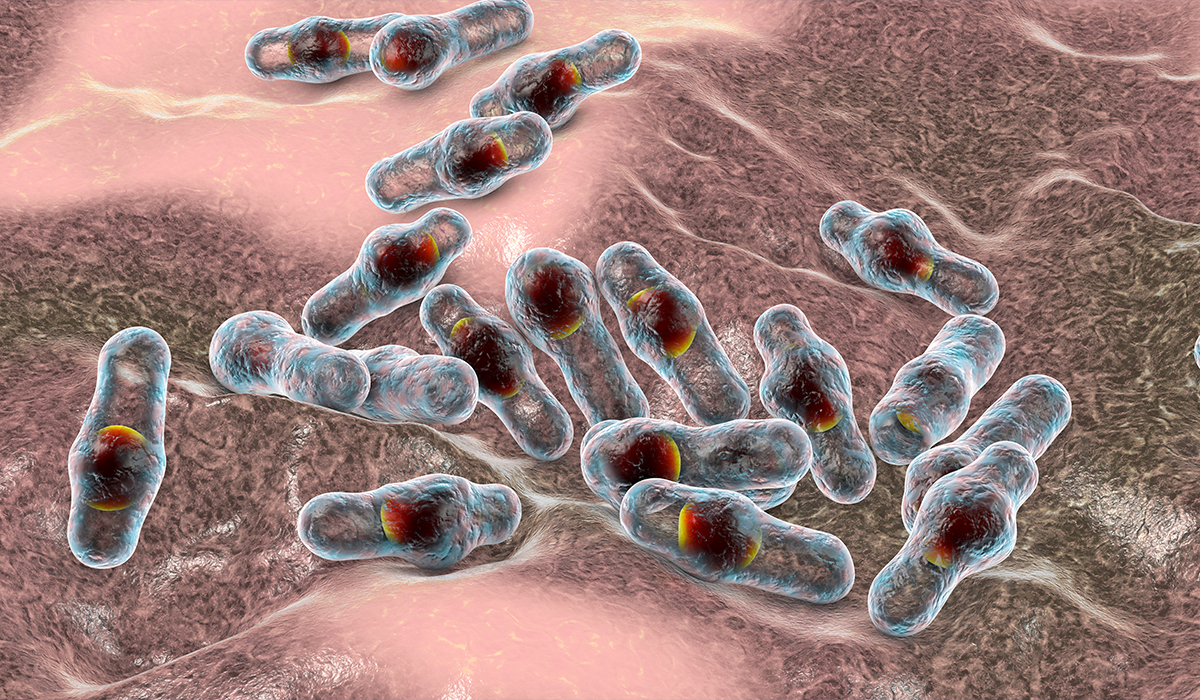Botulism is a rare condition caused by poisoning by the BoNT toxin. Botulinum neurotoxin (BoNT) is a neurotoxic substance produced by strains of the anaerobic bacterium Clostridium botulinum. The toxin can lead to death, causing paralysis and respiratory failure.
Neurological disorders start with cranial nerve paralysis and lead to weakness of the trunk and limbs. Botulinum toxin can be contracted in various ways, the direct cause being the entry of bacteria into the human body.
There are different types of botulism, notably infant botulism, which is related to colonizing bacteria in the intestines. Patients poisoned by botulism should be under hospital care. The bacterium can be detected in the body through microscopic examination. The treatment uses botulinum antitoxin, which can neutralize the harmful toxin. The vaccine is used in groups at increased risk of botulism poisoning. Prevention regarding food storage and preparation is also essential.

Botulism is caused by botulinum neurotoxin (BoNT)![]() , produced by the bacterium Clostridium botulinum
, produced by the bacterium Clostridium botulinum![]() . Strains of the bacteria are commonly found in soil—the toxin's systemic action results in neuroparalytic syndrome. Due to its high potency, this bacterial toxin is considered the most lethal known toxin. The toxins produced by Clostridium botulinum bacteria are potent and particularly dangerous because they damage the nervous system.
. Strains of the bacteria are commonly found in soil—the toxin's systemic action results in neuroparalytic syndrome. Due to its high potency, this bacterial toxin is considered the most lethal known toxin. The toxins produced by Clostridium botulinum bacteria are potent and particularly dangerous because they damage the nervous system.
Neurotoxins act on the presynaptic nerve endings at the synapses of the parasympathetic nervous system and the neuromuscular junctions. The action of the toxins causes irreversible inhibition of acetylcholine![]() , resulting in symptoms of paralysis. There are different types of botulism toxins, but only a few of them have a poisonous effect on humans. Poisoning can occur in the following ways:
, resulting in symptoms of paralysis. There are different types of botulism toxins, but only a few of them have a poisonous effect on humans. Poisoning can occur in the following ways:
Most commonly, infection occurs due to transmission of the botulism-causing bacterium to the organism via the gastrointestinal route. The toxin usually develops in contaminated meat products, primarily canned![]() meat. Unfresh meat harbors the bacteria, but poisoning can also occur through canned vegetables, fish, mushrooms, and fruit consumption—toxins enter food as contaminants, with soil residues on vegetables and inadequately treated meat. Consumption of honey
meat. Unfresh meat harbors the bacteria, but poisoning can also occur through canned vegetables, fish, mushrooms, and fruit consumption—toxins enter food as contaminants, with soil residues on vegetables and inadequately treated meat. Consumption of honey![]() , corn syrup
, corn syrup![]() , and herbal infusions
, and herbal infusions![]() can be dangerous for infants, as the products commonly carry C. botulinum spores.
can be dangerous for infants, as the products commonly carry C. botulinum spores.

Botulism also occurs through the transmission of bacteria through a wound. Therefore, it is possible to contract botulism by wound infection![]() , and the process resembles tetanus. The toxin is produced in a wound infected by the Clostridium botulinum bacteria. Therefore, wound decontamination and proper food storage are also essential to prevent botulism.
, and the process resembles tetanus. The toxin is produced in a wound infected by the Clostridium botulinum bacteria. Therefore, wound decontamination and proper food storage are also essential to prevent botulism.
Iatrogenic botulism arises from the misuse of toxins for cosmetic![]() or therapeutic
or therapeutic![]() purposes, and poisoning is a complication of such procedures. Botulinum toxin is often used in cosmetics and, more specifically, in aesthetic medicine to correct facial features, in particular to smooth out facial wrinkles. The toxin is a very potent poison, but adequately prepared botulinum toxin is safe for patients and is unlikely to cause poisoning of the body in treatments. Infection can occur due to complications when the procedure is not carried out safely.
purposes, and poisoning is a complication of such procedures. Botulinum toxin is often used in cosmetics and, more specifically, in aesthetic medicine to correct facial features, in particular to smooth out facial wrinkles. The toxin is a very potent poison, but adequately prepared botulinum toxin is safe for patients and is unlikely to cause poisoning of the body in treatments. Infection can occur due to complications when the procedure is not carried out safely.
There is also inhalation botulism, which results from the accidental or deliberate release of an aerosolized toxin. However, it is worth noting that inhalation does not involve person-to-person transmission of the bacteria. Inhalational botulism is rare and happens mainly in laboratory![]() settings. Therefore, people working in laboratories are at the risk group for botulism.
settings. Therefore, people working in laboratories are at the risk group for botulism.
Botulism occurs when Clostridium bacteria encounter favorable conditions for germination and toxin production. Temporary colonization of the large intestinal lumen of infants and adults occurs. In the case of infants, the intestinal bacterial flora is not yet developed, so the bacteria in the intestines pose a danger of poisoning. The intestinal microbiota of infants does not have bile acids![]() to inhibit the growth of dangerous bacteria.
to inhibit the growth of dangerous bacteria.
A type of infant botulism is caused by bacteria entering the baby's intestines. The spores of the Clostridium botulinum bacteria can also enter through honey or contact with contaminated soil. In the youngest children, the symptoms of botulism are more challenging to recognize. Botulism that occurs in infants less than one year old can be difficult to diagnose and treat.

Botulism is a poisoning that lasts between 5 and 15 days after the introduction of bacterial spores into the body. Symptoms of botulism can vary depending on age, dose of toxin, and type of infection. If you notice worrying symptoms that may indicate botulism, seek medical attention immediately, as botulism is a dangerous condition that can be fatal. Symptoms of botulism include:
Bulbar symptoms are the term used to describe the symptoms of cranial nerve palsy![]() . Botulism usually begins with these symptoms, consist the symmetrical weakness of the trunk, limbs, and smooth muscles. Eventually, the paralysis progresses to flaccidity and paralysis. The weakness and fatigue are intense and often accompanied by paresthesias
. Botulism usually begins with these symptoms, consist the symmetrical weakness of the trunk, limbs, and smooth muscles. Eventually, the paralysis progresses to flaccidity and paralysis. The weakness and fatigue are intense and often accompanied by paresthesias![]() . Paresthesia is an unusual sensation in the limbs or trunk. It includes a feeling of numbness and tingling in the limbs, as well as a sensation of heat or even pain. In addition, botulism can cause a dry mouth sensation, associated with inhibiting saliva and mucus secretion. Sweat production is also impaired.
. Paresthesia is an unusual sensation in the limbs or trunk. It includes a feeling of numbness and tingling in the limbs, as well as a sensation of heat or even pain. In addition, botulism can cause a dry mouth sensation, associated with inhibiting saliva and mucus secretion. Sweat production is also impaired.

Early symptoms also include visual problems. Double vision![]() , or diplopia, is often present, and it can affect one eyeball or both eyes. As you can easily guess, it is a condition during which the patient sees double the object being observed. In addition to this, blurred vision may also occur. Visual disturbances may also include symptoms such as photophobia, convergent strabismus, drooping eyelids, and pupillary dilation.
, or diplopia, is often present, and it can affect one eyeball or both eyes. As you can easily guess, it is a condition during which the patient sees double the object being observed. In addition to this, blurred vision may also occur. Visual disturbances may also include symptoms such as photophobia, convergent strabismus, drooping eyelids, and pupillary dilation.
Further symptoms associated with cranial nerve palsy include dysphagia![]() or difficulty swallowing. The patient has difficulty taking in food. Dysarthia
or difficulty swallowing. The patient has difficulty taking in food. Dysarthia![]() also occurs, which consists of slurred speech. Speech becomes indistinct, and the patient distorts the sounds of the lip and tongue. In addition to dysphagia and flaccid dysarthria, palatal paresis and dysphonia
also occurs, which consists of slurred speech. Speech becomes indistinct, and the patient distorts the sounds of the lip and tongue. In addition to dysphagia and flaccid dysarthria, palatal paresis and dysphonia![]() , or voice alteration, are noted. The abnormalities may concern the acoustic components of the voice, i.e., timbre, frequency, volume level, and duration.
, or voice alteration, are noted. The abnormalities may concern the acoustic components of the voice, i.e., timbre, frequency, volume level, and duration.
Diaphragmatic involvement causes respiratory failure, which is a dangerous condition and can lead to death. It requires treatment in the form of intubation and mechanical ventilation. Respiratory failure causes hypoxia![]() and other complications. This symptom occurs in severe botulism.
and other complications. This symptom occurs in severe botulism.
In botulism, paralysis of autonomic smooth muscle causes constipation and urinary retention![]() , which may be preceded by vomiting and diarrhea. Constipation is a common symptom seen in infantile botulism, and paralysis of intestinal peristalsis causes prominent abdominal bloating. In addition, infants present with weakness, difficulty feeding, weak crying, and drooling.
, which may be preceded by vomiting and diarrhea. Constipation is a common symptom seen in infantile botulism, and paralysis of intestinal peristalsis causes prominent abdominal bloating. In addition, infants present with weakness, difficulty feeding, weak crying, and drooling.
If poisoning has occurred by the gastrointestinal route, nausea, vomiting, and abdominal pain may be among the first symptoms. These gastrointestinal symptoms arise 12 to 72 hours![]() after ingestion of toxin-contaminated food. Symptoms resemble typical food poisoning, but in botulism, there must also be additional symptoms associated with cranial nerve palsy.
after ingestion of toxin-contaminated food. Symptoms resemble typical food poisoning, but in botulism, there must also be additional symptoms associated with cranial nerve palsy.
In the case of botulism, where the cause of infection was bacterial transmission through a wound, symptoms may also involve the skin surface. In such patients, pad symptoms are also accompanied by cellulitis. Fever is also present in such cases. Most cases of wound botulism occur in people who inject drugs like heroin![]() .
.

The diagnosis of botulism can be difficult because the initial symptoms are often uncharacteristic and subtle. In the case of toxin poisoning, prompt treatment is extremely important. People suspected of having botulism undergo a physical examination followed by laboratory and electrophysiological tests.
While confirmation of botulism usually takes a few days, time is essential when treating botulism. Therefore, treatment is often introduced based on a history before results are obtained. Most often, microscopic evaluation for bacterial spores is done by stool examination.
When laboratory results are pending, a presumptive diagnosis process can be made based on a detailed history, physical examination, and electrophysiological examination. This allows early treatment to be undertaken. Electromyography is an electrophysiological examination during which muscle and nerve functions are assessed. EMG is used to diagnose and treat diseases of the nervous and muscular systems.
New diagnostic methods are being investigated to aid in rapidly confirming botulism. Among others, immunological tests![]() have been tried. However, this type of test could be more practical due to the low quality of the antibodies and interfering factors. In addition, endopeptidase assays
have been tried. However, this type of test could be more practical due to the low quality of the antibodies and interfering factors. In addition, endopeptidase assays![]() were tested. In this case, they showed high sensitivity but are still in the research phase.
were tested. In this case, they showed high sensitivity but are still in the research phase.

If botulism is suspected, hospital treatment and action as soon as possible is essential. Treatment of botulism currently consists primarily of the administration of antitoxin![]() . Care and close monitoring is also recommended, especially if the patient has respiratory problems. Sometimes, antibiotics or surgical treatment of the wound is necessary. It is also occasionally essential to remove the toxin by, for example, provoking vomiting, gastric lavage, or deep enemas.
. Care and close monitoring is also recommended, especially if the patient has respiratory problems. Sometimes, antibiotics or surgical treatment of the wound is necessary. It is also occasionally essential to remove the toxin by, for example, provoking vomiting, gastric lavage, or deep enemas.
Antitoxin administration is available in two forms: The first is the heptavalent equine serum antitoxin, indicated for patients over one year of age, i.e., for treating adult botulism. For infant botulism, immunoglobulin of human origin is used. The paralysis resolves slowly, so the recovery process may take time. Currently, the prognosis for botulism is good. Most patients recover completely without experiencing complications.
Antibiotic therapy is necessary in cases of wound botulism. After cleaning or even surgery on the wound, antibiotics such as penicillin and m***********e are administered. Aminoglycosides, on the other hand, are contraindicated because they exacerbate neuromuscular blockade. It is also worth mentioning that antibiotic therapy is not to be used in infants.

Botulism poisoning is rare in the United States but is possible and dangerous. Therefore, prevention is necessary to prevent hazardous cases. Consequently, it is essential to educate the public about proper food storage. Most cases of classical botulism could be prevented.
Clostridium botulism can enter home-canned foods, which is often the case with manufactured and canned food at home. Therefore, the temperature, pressure, and cooking time required to preserve food properly are essential. It is recommended to cook food for 10 minutes, as this deactivates the toxin produced by the bacteria. Preservation correctly kills the Clostridium spores and effectively prevents exposure to the toxin. Infant botulism, on the other hand, is best prevented by avoiding giving honey to infants.
In addition to educating the public about botulism, a vaccine option is being investigated. Pentavalent botulinum toxoid![]() is available for those at increased risk of botulism exposure, including laboratory workers and military personnel. There is not yet an approved vaccine for the general public, and the previously administered vaccine is unsuitable for public use due to high costs and decreased immunogenicity.
is available for those at increased risk of botulism exposure, including laboratory workers and military personnel. There is not yet an approved vaccine for the general public, and the previously administered vaccine is unsuitable for public use due to high costs and decreased immunogenicity.
Botulism leads to severe neurological disorders. The gram-positive bacterium Clostridium botulinum produces botulinum toxin. Under anaerobic conditions, the spores of the botulism bacteria become active, multiply, and make a neurotoxin that poisons the food product or soil. Est is the most potent poison the bacteria produces; however, poisoning is rare. Early symptoms of botulism may be uncharacteristic—these include muscle weakness and flaccidity, various disturbances, and sometimes gastrointestinal symptoms. Diagnosis can be difficult; lab tests to confirm the disease may take time. Treatment, on the other hand, should be applied immediately.
Table of Contents

Sleep paralysis is a condition in which you experience a feeling of inertia of the entire body. What are the… read more »

If food is spoiled, undercooked, or contains certain types of bacteria, toxins, or other harmful substances, it may cause food… read more »

Also known as lockjaw, tetanus is an infectious disease spread by spores of Clostridium tetani bacteria, which can be found everywhere in the… read more »

Gangrene is tissue necrosis caused by infection with anaerobic bacteria. How to recognize this disease? What does treatment and prevention… read more »

Sun Poisoning is a more severe form of sunburn. Additional distressing symptoms may occur. Learn about the effects of sun… read more »

C. Diff is the abbreviated name for the bacteria that causes infections in the gut. It causes diarrhea and other… read more »

Polio is a disease that is now very rare. However, not being vaccinated can increase the risk. Find out about… read more »

Gastroenteritis is a diarrheal disease. Viral infections are a common cause. How to recognize it? How is gastroenteritis treated? read more »

Hyperhidrosis is the term for excessive perspiration. Find out what hyperhidrosis can indicate. Learn about the most effective treatment methods. read more »